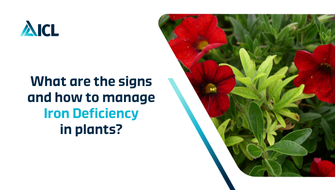Molybdenum (Mo) deficiency is a condition where plants do not receive an adequate supply of molybdenum, which is an essential trace element required for their growth and development. Although required by the plant in very small amounts, any shortage will lead to very pronounced deficiency symptoms on the leaves.
Molybdenum plays a crucial role in various biochemical processes within plants, including nitrogen metabolism and the conversion of nitrate to ammonia.
Where can Molybdenum deficiencies occur in the plant?
Molybdenum is considered a relatively immobile nutrient within the plant, meaning that once it is taken up by the roots, it does not readily translocate to other parts of the plant. As a result, deficiency symptoms tend to appear in the older leaves rather than the younger, actively growing tissues.
Ornamental plants such as Zinnias may show reduced flower production and leaf discoloration. Poinsettias are very sensitive to trace element imbalances and will exhibit a range of symptoms on their leaves.
What are the symptoms of Molybdenum Deficiency?
- Yellowing of Leaves: One of the most common symptoms is interveinal chlorosis, where the area between the veins of the leaves turns yellow, while the veins remain green. This is particularly noticeable in the older leaves.
- Stunted Growth: Molybdenum deficiency can lead to reduced plant growth, including shorter stems and smaller overall plant size.
- Leaf Curling: Leaves may curl or become distorted in shape.
- Poor Flower and Fruit Development: Deficient plants may produce fewer flowers and fruits, and the ones that do develop may be smaller and lower in quality.
- Necrosis: In severe cases, necrotic (dead) spots may appear on the leaves.
- Reduced Nitrogen Uptake: Molybdenum is necessary for the conversion of nitrate (NO3-) to ammonia (NH4+). When molybdenum is deficient, plants may struggle to take up and utilise nitrogen, leading to nitrogen-related symptoms like reduced protein synthesis.

Molybdenum Deficiency in Ribes
What are the impacts of Molybdenum Deficiency?
- Reduced Growth: Molybdenum deficiency can result in stunted growth and reduced flowering.
- Quality Reduction: Plants with deficiency symptoms will have a lower quality and market value.
- Lower Nitrogen Use Efficiency: Molybdenum deficiency affects nitrogen metabolism, making plants less efficient in using available nitrogen resources.

Molybdenum Deficiency in Caryopteris
How should you manage Molybdenum Deficiency?
- Growing Media Testing: Regular testing is essential to monitor nutrient levels, including molybdenum. Leaf analysis can also be used to diagnose deficiencies in Poinsettia.
- pH Adjustment: Molybdenum availability in the root zone is influenced by growing media pH. As Molybdenum is less soluble and available to plants at lower pH’s commonly found in Peat based growing media. A positive note on the increasing use of Peat Free growing media, with inherently higher pH, is a lower chance of Molybdenum deficiency. Water quality should also be considered as water quality , Hard or Soft, can affect pH of the growing media.
- Fertiliser: If media tests indicate molybdenum deficiency, it can be corrected through the addition of a suitable fertiliser. Molybdenum can be applied as a component of a trace element containing fertiliser.
- Foliar Sprays: Due to the poor movement of Molybdenum within the plant, in cases of severe deficiency, foliar applications of molybdenum-containing fertilisers can provide a quick remedy during critical growth stages.

Molybdenum Deficiency in Philadelphus
It’s essential to address molybdenum deficiency promptly to ensure healthy plant growth. Regular monitoring growing nutrient levels and a drop nutrient plan are key to preventing and correcting deficiencies in ornamental crops that are known to experience symptoms.
Molybdenum is required in very small quantities by the plant, as such it is easy to apply too much Molbdenum in a fertiliser application, and cause Molybdenum toxicity, particularly at low growing media pH, the symptoms of which can be similar to those of deficiency. Molybdenum toxicity may interfere with the uptake and utilization of other essential nutrients, leading to imbalances in the plant.
What is the ICL Solution to a Molybdenum Deficiency?
While specific Molybdenum fertilisers are available, it is safer to apply a balanced trace element package such as Micromax WS TE mix. This contains the full package of essential trace elements, in the correct proportion for ornamental plants.
Plants exhibiting Molybdenum deficiency will need a boost to restore healthy growth and leaf colour. ICL recommend the use of Peters Foliar Feed, an NPK and trace element fertiliser which not only addresses the nutritional needs of the plant but also contains the unique M77 plant growth promoting package, ensuring plants quickly recover normal growth.
To avoid deficiency symptoms occurring in the first place, discuss your crop with your local ICL technical sales representative , who will utilise AngelaWeb 3.0 to produce a Growing Solution for you incorporating a combination of Osmocote 5, Peters or Universol fertliisers
0 Brands found
1 Product found
13 Resources found



Our knowledge
Tips & tricks, disease prevention, crop and market related information
Explore our knowledge












